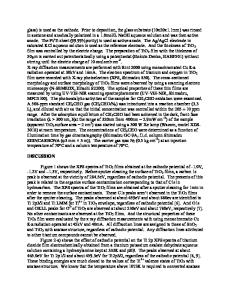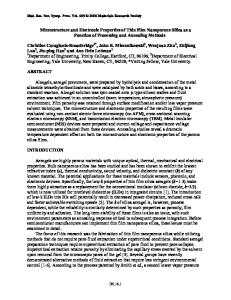Annealing temperature-dependent crystallinity and photocurrent response of anodic nanoporous iron oxide film
- PDF / 699,120 Bytes
- 10 Pages / 584.957 x 782.986 pts Page_size
- 92 Downloads / 452 Views
Go Kawamura and Atsunori Matsuda Department of Electrical and Electronic Engineering, Faculty of Engineering, Toyohashi University of Technology, Aichi 441-8580, Japan (Received 24 February 2016; accepted 12 May 2016)
The effects of annealing temperatures on the structure and photocurrent response of nanoporous iron oxide film prepared by anodization of iron foil in an ethylene glycol, NH4F, and H2O electrolyte were studied. The as-anodized anodic film was found to be rather amorphous and crystallized to predominantly a-Fe2O3 upon annealing in nitrogen. Nitrogen was used as to reduce the thickening of the barrier layer which affects the photocurrent response of the oxide. However, annealing must be done above 300 °C to produce crystalline oxide but must be kept lower than 500 °C since high temperature promotes grain growth, destroying the nanoporous structure and also thickens the barrier layer, which significantly reduce the photocurrent of the film. Sample annealed at 450 °C in nitrogen has the highest photocurrent of 1.04 mA/cm2 (0.5 V versus Ag/AgCl in 1 M NaOH) compared to 0.13 mA/cm2 at 0.5 V for air-annealed sample.
I. INTRODUCTION
Alpha-phase iron(III) oxide (hematite, a-Fe2O3) is a semiconductor possessing characteristics necessary for application in efficient and scalable solar energy conversion devices. For instance, a-Fe2O3 is an attractive photoanode material in a photoelectrochemical (PEC) cell for water splitting application as it offers the most obvious advantage: smaller band gap of 2.2 eV which corresponds to the utilization of 40% of solar irradiation for electron–hole pairs formation. When electron–hole pairs are formed the chemical equilibrium in the PEC cell is disturbed, a photovoltage that gives rise to a photocurrent will be developed. The photocurrent can be measured and the circuit of electrons is completed by electrons transfer process at the cathodejelectrolyte interface. Here, hydrogen is produced1 and can be collected. At anode, holes are transferred forming oxygen gas. In competition with charge transfer process is electron and hole recombination. Recombination rapidly diminishes free carriers reducing the photon conversion efficiency hence diffusion of carriers like holes for instance to the electrodejelectrolyte interface must be as rapid as possible. It is however known that a-Fe2O3 has a short hole diffusion length (;2–4 nm) consequently most Contributing Editor: Xiaobo Chen Address all correspondence to these authors. a) e-mail: [email protected] b) e-mail: [email protected] DOI: 10.1557/jmr.2016.206 J. Mater. Res., 2016
http://journals.cambridge.org
Downloaded: 12 Jun 2016
holes are recombined with free electrons before they can be successfully transferred out.2 Obviously this reduces the solar to hydrogen conversion efficiency of the photoanode as much of the electrons are now recombined with free holes before they are successfully transferred at the cathode to generate hydrogen. Exploiting ordered nanoporous film with pore wall thickness to be as thin as possible has been proposed
Data Loading...








